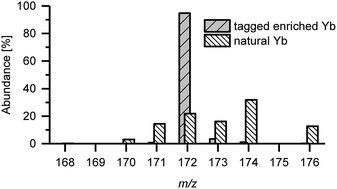On-line reverse isotope dilution analysis for spatial quantification of elemental labels used in immunohistochemical assisted imaging mass spectrometry via LA-ICP-MS
Abstract
We present a novel on-line isotope dilution analysis (IDA) approach for the quantification of isotopically enriched metal labels used in immunohistochemical assisted imaging mass spectrometry. This technique advances recently reported on-line IDA for laser ablation-inductively coupled plasma mass spectrometry (LA-ICP-MS) by performing on-line reverse IDA of isotopically enriched elements commonly used as labels for antibodies. This approach allows relative quantification of biomolecules and is superior to other methods that have long acquisition times such as three-dimensional LA-ICP-MS, or when higher sample throughput is required. As a proof of concept, anti-tyrosine hydroxylase was labelled with Yb isotopes and incubated on two parallel cryocut sections of a mouse brain. IDA dependent parameters were determined by ablation of matrix-matched standards. Quantification by IDA was compared against external calibration and was a more robust method, unaffected by sensitivity changes originating from plasma drifts or spontaneous plasma fluctuations.



 Please wait while we load your content...
Please wait while we load your content...